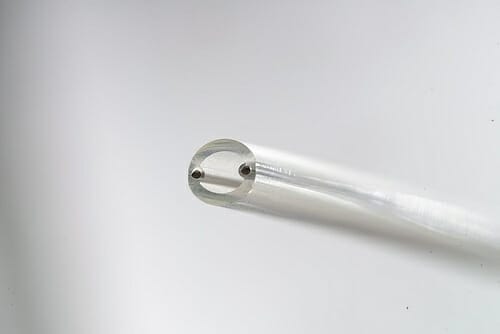
What is linear wire reinforced extrusion?
Linear wire reinforcement incorporates additional fibers into the tube wall. The added fibers can give structural support by boosting tensile strength and restricting elongation or providing electrical data transmission capabilities—important qualities for certain specialized medical tubing.
What options should you keep in mind when procuring linear wire reinforced tubing?
Reinforcement material, tensile strength, size and placement of the elements are critical aspects with linear reinforcing.
Why would you choose this reinforced extrusion over others?
- Longitudinal wires or fibers incorporated into an extrusion cross section provide specific benefits, such as structural support or electrical data transmission.
- Wires can also provide excellent stretch resistance, but limit flexibility depending on the number and location of reinforcing members.
- It is also possible to combine braided or spiral reinforcing with linear reinforcing elements to produce a hybrid design.
- Additional wires can form curves and bends in the tubing, preferable for some medical device applications.
What material is linear wire reinforced tube typically comprised of and why?
- High-tensile stainless steel round wire is commonly used for wire reinforcing. In thin wall sections, flat wire provides an excellent alternative—this maintains a lower wall profile.
- Other materials, such as aramid fiber or polymer monofilaments, can also be used for specialty linear reinforcement applications.
What base materials can longitudinal reinforcement be added to?
Longitudinal fibers or wires can be added to almost any thermoplastic material. These include, but are not limited to: Pebax, PU, Nylon, PE, PEEK, Polyester, and PVC.
What other options are available from Putnam Plastics for fiber reinforced tubes?
- Putnam can incorporate longitudinal reinforcement with braiding and coiling extrusion technology for enhanced strength characteristics.
- Our linear wire reinforced tubing expertise can also be combined with our multi-lumen technology to create a strong, thin catheters with multiple tubes for integrating applications while minimizing patient trauma.
What medical procedures is longitudinally reinforced tubing commonly used in?
Longitudinal reinforced medical tubing is used in a variety of catheters that need deflection and steerability.
What ISO certifications is Putnam equipped to comply with?
Putnam’s state-of-the-art custom tubing manufacturing facility is ISO 13485:2016 certified. Our dedicated clean room meets the demand for greater regulatory controls for thermoplastic extrusion and finishing components of medical devices.

Why is Putnam Plastics the best choice for this product?
As a medical extrusion technology leader, Putnam can custom design and manufacture—from prototype to full scale production— even your most complex and challenging tubing orders.
Over 40 years of experience and some of the best engineering minds in the plastics business ensure excellence and dependability. To speak with a Putnam engineer or sales representative about your medical tubing needs, click below.
